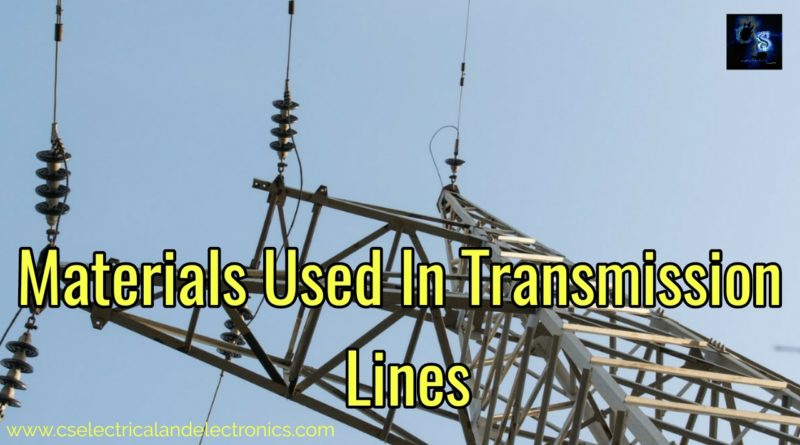Materials Used In Transmission Lines And Their Specifications
Hello everyone, in this article I will discuss materials used in transmission lines and specifications of materials used in transmission lines.
If you want an article on some other topics then comment us below in the comment section. You can also catch me @ Instagram – Chetan Shidling.
Also read – Automotive Electronics Questions And Answers.
Materials Used In Transmission Lines
1. Towers
Lattice steel towers are used for transmission at 33 KV and board-based lattice – steel towers are used for transmission purposes at 66 KV and above. The lattice, broad-base – steel towers are mechanically stronger and have got longer life. Due to their robust construction long spans (300 m or above ) can be used and are much useful for crossing fields, valleys, rivers, etc.,
Steel towers are fabricated from painted or galvanized angle sections. Which can be transported separately and the erection done on-site. The height of the tower depends on the line voltage length of the span and legs of the towers are set in special concrete foundations.
Steel towers can be classified as tangent towers and deviation towers. The tangent towers are used for intermediate support i.e., with 0 degrees to 2-degree line deviation. Deviation towers are further classified as B, C, and D towers depending upon the angle of deviations.
B-type towers are used for 2 degrees to 15-degree line deviation. The c-type tower is used for 15 degrees to 30-degree line deviation or for anchoring. D-type towers are used for the above 30-degree line deviation with anchoring.
Specification: Fabricated galvanized iron steel/towers with bolt and nuts, grill-age with rivets, anti-climbing devices, bird-guards, Number plates, phase plates, danger plates complete structure weighing approximately as shown in the table below.
Concept of Single Circuit and Double Circuit Transmission lines
In a single circuit transmission line, three conductors corresponding to three distinct phases i.e., R, Y, and B phases are run on the transmission towers. whereas in a double circuit transmission line total of six conductors are provided to make two different transmission circuits.
In a double circuit transmission line, the number of circuits is two each consisting of three conductors corresponding to three phases. In a double circuit Transmission line, bundle conductors are mostly wired.
If the number of conductors per bundle is 2 then it will be 220 KV line while if the number of conductors per bundle is four then it will be 400 KV line. The double circuits are used where greater reliability is needed. This system of transmission enables the transfer of more power over a particular distance.
This transmission is thus cheaper and requires less land and is considered ideal from an ecological and aesthetic point of view. Further, due to the double circuit transmission line the reliability of power supply increases. Not only reliability rather maintenance opportunity also increases.
2. Extension piece
An extension piece of fabricated steel structure of 3 M or 6 M may be used in order to achieve the minimum clearance to the ground as per I.E rule.
3. Conductor
The conductor is one of the important items in a transmission and distribution system. The cost of the conductor material accounts for a major part of the total cost. The most commonly used conductor materials for over headlines are as follows ;
- (a) For 66 KV line normally coyote A.C.S.R conductor of 26/2.54 mm (aluminum conductor) 7/1.9 mm (steel).
- (b) For 110 KV lines normally Lynx (A.C.S.R 30/7/2.79 mm).
- (c) For 220 KV line normally Drake (A.C.S.R 30/7/4.27 mm) when calculating the length of conductor 1.5% extra provision is to be provided for the allowance of sag.
4. A.C.S.R conductor Hardware
- (a) Suspension-clamp: Suspension clamp with arcing horns for holding insulators disc are used for A-type towers.
- (b) Strain clamp: Strain clamps are provided for all type towers other than A-type to hold the group of disc insulators with arcing horns. On both sides of a conductor on a tower (2 No for each conductor).
- (c) Midspan compression joint: This joint is used for making joints between two separate conductors. Assuming conductors areas 10 KM length in each roll approximately 3 mid-span compression joints are required for each 20 KM run of the line (for 3-phase).
This joint excellent for joining heavy A.C.S.R conductors. The steel core and aluminum stand are gripped separately and filling of joints are not required.
- (d) Repair sleeves of Aluminium: Repair-sleeves employed for repairing of A.C.S.R or all-aluminum conductors that have sustained surface – damage causing a few aluminum strands to be damaged or broken which can be assumed to be one for each 5 KM run of the conductor.
- (e) Vibration Dampers: Vibration Dampers are to be placed below the conductors at the supporting points for bottom conductors. The number of dampers required for A-type tower is one whereas for all other types it is two as there are two supporting points in them.
- (f) Armor rods: Each ‘A’ type tower requires 3 (for – phases) armor rods.
- (g) Disc insulators: At high voltages, the pin type insulators become bulky, cumbersome, and costly.
Hence for high voltages, the disc insulators are developed. How many insulators the string consists of depending upon the working voltage, type of transmission construction, and size of the insulator used.
For ‘A’ type towers suspension string of disc insulator and for other types of towers on both sides, tension string disc insulator is to be used.
5. Ground Wire
The ground wire of 7 strands 8 SWG steel wire is made to run at the top of the tower to damp the lighting effects.
6. Ground wire accessories
- (a) Strain clamps are 2 numbers required for all types of towers other than ‘A’- type to hold the ground wire.
- (b) Suspension clamp for ‘A’ type towers one clamp is required to hold the ground wire.
- (c) Mid-span compression joints are required to connect two ground wire together i.e., to make joint.
- (d) Repair sleeves are to be used for ground wire whenever there is damage in the wire.
7. Earthing Materials
- (a) Earthing: 40 mm diameter class ‘C’ G.I pipe, 3 mm thick, 2.5 M long holes drilled at intervals of 300 mm all along the length of the pipe. The whole pit of 340 mm diameter is filled with charcoal and salt, the cement concrete tank for adding water at the top is to be closed by M.S plate at the top as per I.E Rule.
- (b) Earth strip: 40 mm * 3 mm aluminum strips are used to connect the tower with earth pipe, through lugs and bolts nuts. Each tower may require 5 M of the strip.
- (c) Lugs: To connect tower and strip with earth pipe, lugs with bolts nuts are used.
8. Boards
- (a) Phase plates: On each tower of HT transmission lines phase plates indicating the different phases (red, yellow, and blue) are provided.
- (b) Danger plates: On each pole or tower of HT transmission line a danger plate indicating the working voltage of the line and word “Danger” is provided at a height of at least 2.4 meters from the ground.
- (c) Anti-climbing devices: To safeguard against the climbing by an unauthorized person, GI barbed wire is placed around the poles at a height of 2.5 meters from the ground for at least 1 meter. on towers, it is provided at a height of 3 meters to 4.5 meters.
- (d) Cement concrete materials: Cement concrete (1 : 2: 4) including the lean concrete is to be done for the foundation of stubs and templates of the tower. The earth excavation is to be done will be double the volume of concrete. The volume of concrete is in cubic meters depends on the type and KV of the tower.
I hope this article may help you all a lot. Thank you for reading. If you have any doubts in materials used in transmission lines, then comment below.
Tags: Materials Used In Transmission Lines And Their Specifications.
Also, read:
- 10 Tips To Maintain Battery For Long Life, Battery Maintainance
- 10 Tips To Save Electricity Bills, Save Money By Saving Electricity
- 100 (AI) Artificial Intelligence Applications In The Automotive Industry
- 100 + Electrical Engineering Projects For Students, Engineers
- 1000+ Control System Quiz, Top MCQ On Control System
- 1000+ Electrical Machines Quiz, Top MCQs On Electrical Machines
- 1000+ MATLAB Simulink Projects For MTech, Engineering Students
- 50 Tips To Save Electricity At Home, Shop, Industry, Office
- 50+ Question And Answer On The Substation, Electrical Question
- 500+ Matlab Simulink Projects Ideas For Engineers, MTech, Diploma
- 500+ Projects For Diploma Electrical, Electronics Student, Diploma Project
- Active Cell Balancing Using A Flyback Converter Simulation In Matlab Simulink
- AI Artificial Intelligence Applications In Electric Vehicles | Future?
- AI Tools For Electronic Circuit Design, Which Is Best?
- Applications Of Artificial Intelligence (AI) In Renewable Energy
- Automotive Industry Or VLSI Chip Industry ? Which Is Best?
- Basic Electrical Engineering, Terms, Definitions, SI Unit, Formula
- Basic Electrical Quiz, Take Online Test On Basic Electrical, Electrical Quiz
- Battery C Rate Online Calculator With Time Calculation
- Battery Management Systems In Electric Vehicles, BMS Operations
Author Profile
- Chetu
- Interest's ~ Engineering | Entrepreneurship | Politics | History | Travelling | Content Writing | Technology | Cooking
Latest entries
 All PostsApril 19, 2024What Is Vector CANoe Tool, Why It Is Used In The Automotive Industry
All PostsApril 19, 2024What Is Vector CANoe Tool, Why It Is Used In The Automotive Industry All PostsApril 13, 2024What Is TCM, Transmission Control Module, Working, Purpose,
All PostsApril 13, 2024What Is TCM, Transmission Control Module, Working, Purpose, All PostsApril 12, 2024Top 100 HiL hardware in loop Interview Questions With Answers For Engineers
All PostsApril 12, 2024Top 100 HiL hardware in loop Interview Questions With Answers For Engineers All PostsMarch 22, 2024Driver Monitoring Systems In Vehicles, Working, Driver Sleepy Alert
All PostsMarch 22, 2024Driver Monitoring Systems In Vehicles, Working, Driver Sleepy Alert








